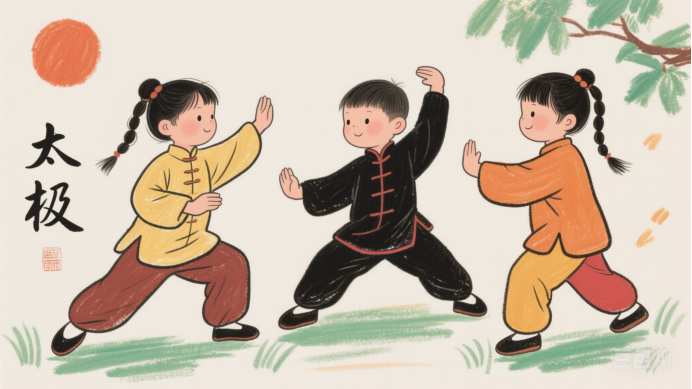
Tai Chi, a precious part of China’s cultural heritage, is more than just exercise — it’s a blend of health, philosophy, and tradition. With roots in ancient Chinese wisdom, this gentle practice helps people stay healthy while teaching the importance of balance in life.
Tai Chi’s history began over 3,000 years ago with the Yijing (Book of Changes), which introduced the ideas of yin and yang — opposite forces that exist in harmony. During the Ming Dynasty, Chen Wangting created Chen-style Tai Chi by mixing martial arts with these philosophies. His movements, inspired by nature and battle, were slow yet powerful, forming the foundation of modern Tai Chi.
Practicing Tai Chi offers many health benefits. Its slow, flowing motions improve strength, balance, and flexibility without straining muscles. Studies show it helps older adults avoid falls by training their body awareness. Mentally, it reduces stress and brings peace, earning it the name “meditation in motion”. Unlike sports that need equipment, Tai Chi is for everyone — young or old, healthy or recovering.
Over time, Tai Chi has developed into styles like Chen, Yang, Wu, and Sun. Chen-style includes quick and slow moves, while Yang-style focuses on smooth, gentle forms. Though different, all styles share the same principles: softness, balance, and harmony between mind and body.
Starting Tai Chi is easy. Beginners should join a class with a skilled teacher. Classes usually begin with warm-ups like shoulder rolls, followed by learning simple movements. Comfortable clothes and flat shoes are recommended. Practicing just 15 minutes daily can make a difference. If classes aren’t available, videos can help, but learning with others is best for support and feedback.
Today, Tai Chi is loved worldwide. It’s not only exercise but also a way to connect with Chinese culture. Parks in China are filled with people practicing at sunrise, showing its timeless appeal. As a gift from China, Tai Chi teaches the world about balance, health, and inner peace. By practicing it, we honor ancient wisdom while caring for our bodies and minds — a tradition that continues to inspire generations.
原创编写 版权所有 侵权必究! 每日更新 个性化阅读 英语飙升!
1.1. What can we infer about Tai Chi from Paragraph 2?
A It started with martial arts.
B It has 3,000 years of history.
C Yin and yang inspired its creation.
D Chen Wangting created most styles.
解析:选C。 C 推理判断题。根据第二段内容可知,太极拳的历史始于《易经》引入的阴阳观念,在明朝陈王廷将武术与这些哲学融合创造了陈式太极拳,由此可推断阴阳观念启发了太极拳的创造。故选C。
2.2. What does the underlined word “straining” probably mean?
A Relaxing.
B Injuring.
C Strengthening.
D Exercising.
解析:选B。B 词义猜测题。根据第三段的“Its slow, flowing motions improve strength, balance, and flexibility without straining muscles”可知,太极拳缓慢流畅的动作在不“straining”肌肉的情况下提高力量、平衡和灵活性,这里讲的是太极拳的好处,结合语境可推断straining的意思是“损伤,损害”,与injuring意思相近。故选B。
3.3. What does Paragraph 4 mainly tell readers?
A The development of Tai Chi styles.
B The differences between Tai Chi masters.
C The competition among Tai Chi styles.
D The rules of practicing Tai Chi.
解析:选A。A 段落大意题。根据第四段内容可知,该段主要讲述了随着时间推移,发展出了不同风格的太极拳以及这些风格的特点和共性,即太极拳风格的发展。故选A。
4.4. What can we know about practicing Tai Chi?
A Teachers are unnecessary.
B Special shoes are needed.
C Group learning is better.
D Long practice is required.
解析:选C。C 推理判断题。根据第五段的“If classes aren’t available, videos can help, but learning with others is best for support and feedback”可知,小组学习(和他人一起学习)能获得支持与反馈,效果更好。文中强调初学者应参加有经验老师的课程,说明老师是必要的,A项错误;文章中只是推荐穿平底鞋,并非需要特殊鞋子,B项错误;每天练习15分钟就有效果,并非需要长时间练习,D项错误。故选C。
